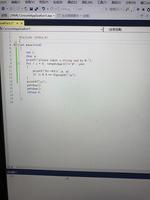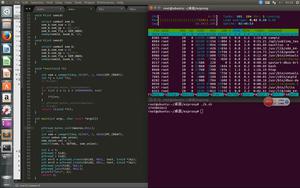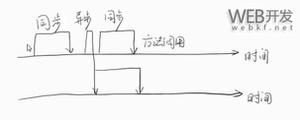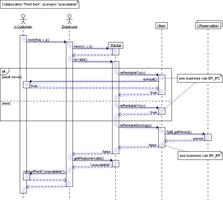AQS唤醒后继线程 为什么是从后向前遍历

private void unparkSuccessor(Node node) { /*
* If status is negative (i.e., possibly needing signal) try
* to clear in anticipation of signalling. It is OK if this
* fails or if status is changed by waiting thread.
*/
int ws = node.waitStatus;
if (ws < 0)
compareAndSetWaitStatus(node, ws, 0);
/*
* Thread to unpark is held in successor, which is normally
* just the next node. But if cancelled or apparently null,
* traverse backwards from tail to find the actual
* non-cancelled successor.
*/
Node s = node.next;
if (s == null || s.waitStatus > 0) {
s = null;
for (Node t = tail; t != null && t != node; t = t.prev)
if (t.waitStatus <= 0)
s = t;
}
if (s != null)
LockSupport.unpark(s.thread);
}
如果没有合法的数据,从后向前遍历,为什么这么做呢?从前向后不行吗?
回答:
Node s = node.next;if (s == null || s.waitStatus > 0) {
s = null;
for (Node t = tail; t != null && t != node; t = t.prev)
if (t.waitStatus <= 0)
s = t;
}
if (s != null)
LockSupport.unpark(s.thread);
如果下一个节点为空或者被取消,则从后向前遍历。下一个都是空了,也没办法next吧。如果下一个节点是正常节点,也没有说一定要从后向前。
回答:
我目前测试出来的一个原因是和acquireQueued方法有关。
acquireQueued方法中有
p.next = null; // help GC
因为执行到这里,p.next关联的线程已经获取到锁了,不需要再根据next唤醒线程了。所有置p.next = null,然后unparkSuccessor中就可能需要从tail开始往前遍历了。
final boolean acquireQueued(final Node node, int arg) { boolean failed = true;
try {
boolean interrupted = false;
for (;;) {
final Node p = node.predecessor();
if (p == head && tryAcquire(arg)) {
setHead(node);
p.next = null; // help GC
failed = false;
return interrupted;
}
if (shouldParkAfterFailedAcquire(p, node) &&
parkAndCheckInterrupt())
interrupted = true;
}
} finally {
if (failed)
cancelAcquire(node);
}
}
下边是我用idea调试,代码如何执行才会导致从后向前遍历。
public static void main(String[] args) { ReentrantLock reentrantLock = new ReentrantLock();
for (int i = 0; i < 2; i++) {
new Thread(() -> {
try {
reentrantLock.lock();
//Thread.sleep(10000);
reentrantLock.unlock();
} catch (Exception e) {
e.printStackTrace();
}
}).start();
}
}
一共两个线程,假设命名为thread-0和thread-1。
- 让thread-0执行到reentrantLock.unlock();
- 让thread-1尝试获取锁,然后会进入acquireQueued方法,让for循环执行一次。之所以执行一次是为了让p.waitStatus=-1。
- 让thread-0释放锁,最终进入unparkSuccessor方法。先不往后执行。
- 让thread-1继续执行,会走到了p.next = null 这里。
- 这个时候你如果让thread-0继续执行,就会走到从后向前遍历的部分。
这是我找到的一种情况。
我搜索到的很多文章的说法是在addWaiter方法中:
private Node addWaiter(Node mode) { Node node = new Node(Thread.currentThread(), mode);
// Try the fast path of enq; backup to full enq on failure
Node pred = tail;
if (pred != null) {
node.prev = pred;
if (compareAndSetTail(pred, node)) {
//说代码执行到这里,node已经是尾节点了,但是pred.next = node没执行,next可能存在短暂为null
pred.next = node;
return node;
}
}
enq(node);
return node;
}
但是我没调试出来。
回答:
当下个节点为已取消时,当前节点的下个节点是不确定的,所以需要从后往前获取。
如下的取消函数,在取消时,先修改状态为cancelled,然后再修改指向下个节点的指针为自身,
如果获取唤醒线程正好卡在两个操作之间,则会导致从前往后遍历获得唤醒线程失败。
有两种可能,第一种进入死循环,第二种获取的不是第一个待唤醒的线程
private void cancelAcquire(Node node) { // Ignore if node doesn't exist
if (node == null)
return;
node.thread = null;
// Skip cancelled predecessors
Node pred = node.prev;
while (pred.waitStatus > 0)
node.prev = pred = pred.prev;
// predNext is the apparent node to unsplice. CASes below will
// fail if not, in which case, we lost race vs another cancel
// or signal, so no further action is necessary.
Node predNext = pred.next;
// Can use unconditional write instead of CAS here.
// After this atomic step, other Nodes can skip past us.
// Before, we are free of interference from other threads.
// 修改状态
node.waitStatus = Node.CANCELLED;
// If we are the tail, remove ourselves.
if (node == tail && compareAndSetTail(node, pred)) {
compareAndSetNext(pred, predNext, null);
} else {
// If successor needs signal, try to set pred's next-link
// so it will get one. Otherwise wake it up to propagate.
int ws;
if (pred != head &&
((ws = pred.waitStatus) == Node.SIGNAL ||
(ws <= 0 && compareAndSetWaitStatus(pred, ws, Node.SIGNAL))) &&
pred.thread != null) {
Node next = node.next;
if (next != null && next.waitStatus <= 0)
// 修改上一个等待节点的下个节点为取消节点的下个节点。
compareAndSetNext(pred, predNext, next);
} else {
unparkSuccessor(node);
}
node.next = node; // help GC
}
}
以上是 AQS唤醒后继线程 为什么是从后向前遍历 的全部内容, 来源链接: utcz.com/p/944175.html









